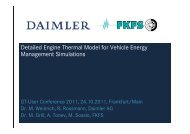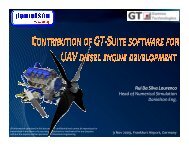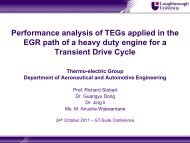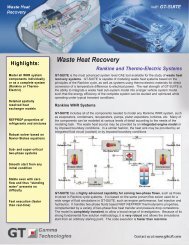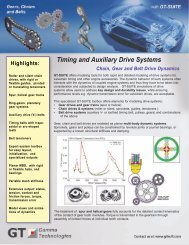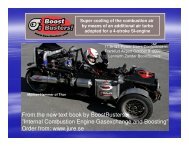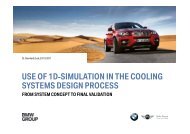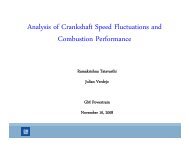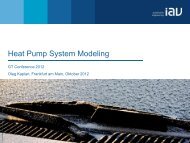Control Engineering with a Transient Model of a Fuel Cell Coolant ...
Control Engineering with a Transient Model of a Fuel Cell Coolant ...
Control Engineering with a Transient Model of a Fuel Cell Coolant ...
Create successful ePaper yourself
Turn your PDF publications into a flip-book with our unique Google optimized e-Paper software.
<strong>Control</strong> <strong>Engineering</strong><br />
<strong>with</strong> a <strong>Transient</strong> <strong>Model</strong> <strong>of</strong> a <strong>Fuel</strong> <strong>Cell</strong> <strong>Coolant</strong> Loop in GT-Suite<br />
R. Höß (<strong>Fuel</strong> <strong>Cell</strong> Cooling System, Daimler AG)<br />
R. Höß (<strong>Fuel</strong> <strong>Cell</strong> Cooling System, Daimler AG) | GT-Conference | 22.10.2012<br />
1
<strong>Control</strong> <strong>Engineering</strong><br />
<strong>with</strong> a <strong>Transient</strong> <strong>Model</strong> <strong>of</strong> a <strong>Fuel</strong> <strong>Cell</strong> <strong>Coolant</strong> Loop in GT-Suite<br />
Agenda<br />
1. Context - <strong>Fuel</strong> <strong>Cell</strong> Car-Development at Daimler<br />
2. Introduction - Cooling System for <strong>Fuel</strong> <strong>Cell</strong> Cars<br />
3. <strong>Model</strong>ling<br />
4. <strong>Model</strong> Verification<br />
5. 3 Concepts <strong>of</strong> a Main Fan <strong>Control</strong>ler<br />
6. Simulation and Results<br />
7. Conclusion and Achivements<br />
R. Höß (<strong>Fuel</strong> <strong>Cell</strong> Cooling System, Daimler AG) | GT-Conference | 22.10.2012 2
Context (1)<br />
<strong>Fuel</strong> <strong>Cell</strong> Car Development at Daimler in Nabern<br />
<strong>Fuel</strong> <strong>Cell</strong> Powertrain Development<br />
Kirchheim u.T. (Nabern)<br />
<strong>Fuel</strong> <strong>Cell</strong> System Development<br />
Kirchheim u.T. (Nabern)<br />
<strong>Fuel</strong> <strong>Cell</strong> Stack Development<br />
Vancouver, Canada<br />
R. Höß (<strong>Fuel</strong> <strong>Cell</strong> Cooling System, Daimler AG) | GT-Conference | 22.10.2012 3
Context (2)<br />
The Current Generation <strong>of</strong> <strong>Fuel</strong> <strong>Cell</strong> Vehicle<br />
Technical Data<br />
Vehicle Mercedes-Benz B-Class<br />
<strong>Fuel</strong> <strong>Cell</strong><br />
System<br />
Engine<br />
PEM, 90 kW (122 hp)<br />
Output (Cont./ Peak) 70kW / 100kW (136 hp)<br />
Max. Torque: 290 Nm<br />
<strong>Fuel</strong> Compressed hydrogen (70 MPa)<br />
Range 380 km (NEDC)<br />
Top Speed 170 km/h<br />
Li-Ion Battery<br />
Output (Cont./ Peak): 24 kW / 30 kW (40 hp)<br />
Capacity: 6.8 Ah, 1.4 kWh<br />
• Freeze Start Capability<br />
• Emissions-free (CO 2 )<br />
• Short refueling time and high range<br />
<strong>with</strong> 70 MPa hydrogen storage<br />
• Silent operation<br />
R. Höß (<strong>Fuel</strong> <strong>Cell</strong> Cooling System, Daimler AG) | GT-Conference | 22.10.2012 4
Context (3)<br />
B-Class F-CELL World Drive 2011<br />
• 125 days<br />
• 14 countries<br />
• approx 19000 miles<br />
• Route defined through<br />
Scouting<br />
• Convoy <strong>with</strong> 24 vehicles<br />
• over 50 people<br />
• 2 fueling Stops per day<br />
• 174/155 miles until fueling<br />
stop<br />
• First world tour <strong>with</strong> fuel cell electric vehicles<br />
• Demonstration <strong>of</strong> the technical maturity and performance <strong>of</strong> fuel cell technology<br />
• Demonstration <strong>of</strong> a daily use <strong>of</strong> the fuel cell technology in different climate zones<br />
• Appeal to all involved partners to push the development <strong>of</strong> H 2 -Infrastructure<br />
For future fuel cell vehicle generations, further drive system cost reduction is intended<br />
e. g. by simplification <strong>of</strong> the fuel cell system architecture<br />
R. Höß (<strong>Fuel</strong> <strong>Cell</strong> Cooling System, Daimler AG) | GT-Conference | 22.10.2012 5
Introduction<br />
Cost Reduction by Developing a New Main Fan <strong>Control</strong> Strategy Using GT-Suite<br />
Challenges<br />
▸ For a stable water management and efficient operation <strong>of</strong> the fuel cell stack, the coolant set temperature<br />
and coolant massflow on the fuel cell has to be controlled precisely.<br />
▸ The <strong>Control</strong>ler for the thermostatic control valve and the controller for the main-radiator fan use the same<br />
set point: FC-Stack coolant inlet temperature<br />
R. Höß (<strong>Fuel</strong> <strong>Cell</strong> Cooling System, Daimler AG) | GT-Conference | 22.10.2012 6
<strong>Model</strong>ling (1)<br />
Basic <strong>Model</strong> <strong>of</strong> the <strong>Coolant</strong> Hydraulics and Radiators Air Path<br />
High Temperature <strong>Coolant</strong> Loop<br />
Low Temperature <strong>Coolant</strong> Loop<br />
▸ Starting Point was a basic model <strong>of</strong> the coolant loops and air-paths used for hydraulic balancing and cooling performance<br />
evaluations.<br />
R. Höß (<strong>Fuel</strong> <strong>Cell</strong> Cooling System, Daimler AG) | GT-Conference | 22.10.2012 7
<strong>Model</strong>ling (2)<br />
Extension Step 1: <strong>Control</strong>ler Functions <strong>of</strong> the coolant loops and transient verification<br />
Temp. <strong>Control</strong> Valve<br />
(Switch Characteristics)<br />
Main Fan<br />
(Speed)<br />
Wheelhouse Fan<br />
(Speed)<br />
HT-<strong>Coolant</strong> Pump (Speed)<br />
LT-<strong>Coolant</strong> Pump (Speed)<br />
Off Valves<br />
(Speed)<br />
R. Höß (<strong>Fuel</strong> <strong>Cell</strong> Cooling System, Daimler AG) | GT-Conference | 22.10.2012 8
<strong>Model</strong>ling (3)<br />
Extension Step 2: <strong>Fuel</strong> <strong>Cell</strong> System, Powertrain & Vehicle Environment<br />
Cooling System<br />
Vehicle &<br />
Transmission<br />
Hybridisation Strategy &<br />
Battery<br />
<strong>Fuel</strong> <strong>Cell</strong> System<br />
Cooling <strong>Control</strong> Unit<br />
▸ By adding a simplified, map-based powertrain model a transient vehicle model is achieved .<br />
▸ Track pr<strong>of</strong>iles and cooling controller reactions can be calculated.<br />
R. Höß (<strong>Fuel</strong> <strong>Cell</strong> Cooling System, Daimler AG) | GT-Conference | 22.10.2012 9
<strong>Model</strong> Verification (1)<br />
Test-Drive (0-80km/h, trailer dynamometer): Stack-Performance<br />
▸ The simulation results show a good correlation to the vehicle measurements for the stack performance.<br />
R. Höß (<strong>Fuel</strong> <strong>Cell</strong> Cooling System, Daimler AG) | GT-Conference | 22.10.2012 10
<strong>Model</strong> Verification (2)<br />
Test-Drive (0-80km/h, trailer dynamometer): FC <strong>Coolant</strong> Inlet-Temp., Fan Speed<br />
▸ The simulation results show a good correlation to the vehicle measurements for the coolant set-point and the fan-speed.<br />
R. Höß (<strong>Fuel</strong> <strong>Cell</strong> Cooling System, Daimler AG) | GT-Conference | 22.10.2012 11
Main Fan <strong>Control</strong>ler Concept 1<br />
applied in todays <strong>Fuel</strong> <strong>Cell</strong> propulsed B-Class<br />
<br />
<br />
Map based pilot control <strong>of</strong> the temperature deviation.<br />
<br />
Temperaturedifference on the radiator as set point, representing the cooling performance<br />
on the radiator package.<br />
(+) Robust control concept<br />
(-) Two additional temperature sensors needed on the coolant-inlet and outlet <strong>of</strong> the radiators<br />
R. Höß (<strong>Fuel</strong> <strong>Cell</strong> Cooling System, Daimler AG) | GT-Conference | 22.10.2012 12
Main Fan <strong>Control</strong>ler Concept 2:<br />
PID-<strong>Control</strong>ler, Stack <strong>Coolant</strong> Inlet Temperature as Reference<br />
<br />
<br />
Map based pilot control <strong>of</strong> the temperature deviation.<br />
PID-<strong>Control</strong>ler (Stack <strong>Coolant</strong> Inlettemperature)<br />
(+) Standard <strong>Control</strong> Concept<br />
(-) Same control reference as the Thermostatic Valve – Interference expected.<br />
R. Höß (<strong>Fuel</strong> <strong>Cell</strong> Cooling System, Daimler AG) | GT-Conference | 22.10.2012 13
Main Fan <strong>Control</strong>ler Concept 3<br />
<strong>Model</strong> based <strong>Control</strong><br />
System Waste Heat <strong>Model</strong>:<br />
• Stack Current<br />
• Stack Voltage<br />
Cooling Performance <strong>Model</strong>:<br />
• Vehicle Speed<br />
• Ambient Temp.<br />
• AC Condensation Pressure<br />
• Pump Speed<br />
• LT-<strong>Coolant</strong>temp.<br />
• T-Set_KW1_STM<br />
• T_KW1_STM<br />
• T_KW2_STM<br />
<br />
<br />
Map based pilot control <strong>of</strong> the temperature deviation.<br />
<br />
<strong>Model</strong>based Fan <strong>Control</strong>, based on the calculation <strong>of</strong> the FCS-powertrain - and cooling<br />
performance.<br />
(+) Precise fan control on cooling requirement, similar to Concept 1.<br />
(-) Higer setup and programming effort, higher cpu and memory usage on control unit<br />
R. Höß (<strong>Fuel</strong> <strong>Cell</strong> Cooling System, Daimler AG) | GT-Conference | 22.10.2012 14
Simulation<br />
Comparison <strong>of</strong> the Main Fan <strong>Control</strong>ler Concepts<br />
Concept 1<br />
Predecessor Concept<br />
Concept 2<br />
PID-<strong>Control</strong>ler<br />
Concept 3<br />
<strong>Model</strong> Based <strong>Control</strong><br />
Temperature Overshoot<br />
(mean value <strong>of</strong> drive cycle)<br />
[K]<br />
Total Rejected Heat<br />
[MJ]<br />
Fan Power Consumption<br />
[kJ]<br />
Fan <strong>Control</strong>ler Efficiency<br />
(rejected heat per fans power<br />
consumption in drive cycle)<br />
[-]<br />
Concept 1 3.07923 31.797255 340.04145 93.5<br />
Concept 2 4.71665 30.188025 63.56364 474.9<br />
Concept 3 2.89629 31.902255 377.8782 84.4<br />
▸ The model-based controller concept shows the best potential to fullfill the requirements to precisely control the fuel cell<br />
temperature setpoint and to have a efficient cooling system and achive the cost potential <strong>of</strong> eleminating 2 temp-sensors.<br />
R. Höß (<strong>Fuel</strong> <strong>Cell</strong> Cooling System, Daimler AG) | GT-Conference | 22.10.2012 15
Conclusion and Achivements<br />
<strong>Control</strong> <strong>Engineering</strong> <strong>with</strong> GT-Suite<br />
<strong>Model</strong>ling and Simulation<br />
• Successful setup and simulation <strong>of</strong> a fastrunning fuel cell vehiclemodell <strong>with</strong>in GT-Suite.<br />
• Approved correlation <strong>of</strong> the simulation model even on vehicle-level <strong>with</strong> simulated drive-cycles.<br />
• But the verified transient behavior especially <strong>of</strong> the coolant loop is essential.<br />
<strong>Control</strong> <strong>Engineering</strong><br />
• Evaluation <strong>of</strong> controller concepts regarding effectivity and efficiency <strong>with</strong> this model.<br />
• <strong>Control</strong>ler response can be optimised in detail.<br />
• Maturity <strong>of</strong> control unit s<strong>of</strong>tware can be raised especially in early s<strong>of</strong>tware cycles.<br />
• Test drive efforts for s<strong>of</strong>tware development can be reduced.<br />
• Elemination <strong>of</strong> 2 temperature sensors seem to be achivable.<br />
R. Höß (<strong>Fuel</strong> <strong>Cell</strong> Cooling System, Daimler AG) | GT-Conference | 22.10.2012 16
Thanks for your attention!<br />
For further information please visit:<br />
www.daimler.com/technologie-und-innovation/antriebe/elektrische-antriebe/brennst<strong>of</strong>fzelle<br />
R. Höß (<strong>Fuel</strong> <strong>Cell</strong> Cooling System, Daimler AG) | GT-Confefence | 22.10.2012 17



